parking sensors TOYOTA C-HR 2023 Owners Manual
[x] Cancel search | Manufacturer: TOYOTA, Model Year: 2023, Model line: C-HR, Model: TOYOTA C-HR 2023Pages: 814, PDF Size: 112.62 MB
Page 456 of 814
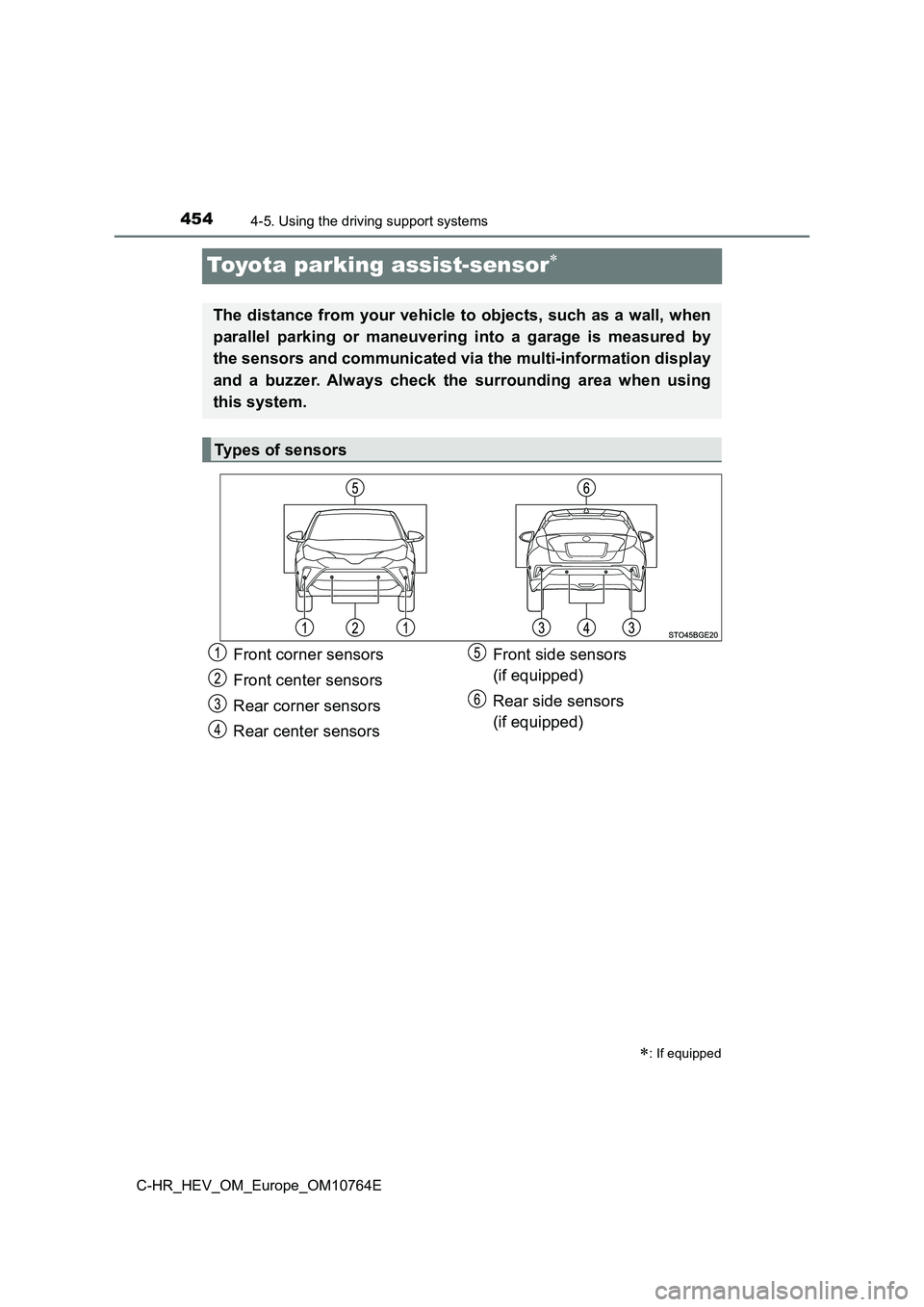
4544-5. Using the driving support systems
C-HR_HEV_OM_Europe_OM10764E
Toyota parking assist-sensor
: If equipped
The distance from your vehicle to objects, such as a wall, when
parallel parking or maneuvering into a garage is measured by
the sensors and communicated via the multi-information display
and a buzzer. Always check the surrounding area when using
this system.
Types of sensors
Front corner sensors
Front center sensors
Rear corner sensors
Rear center sensors
Front side sensors
(if equipped)
Rear side sensors
(if equipped)
Page 457 of 814
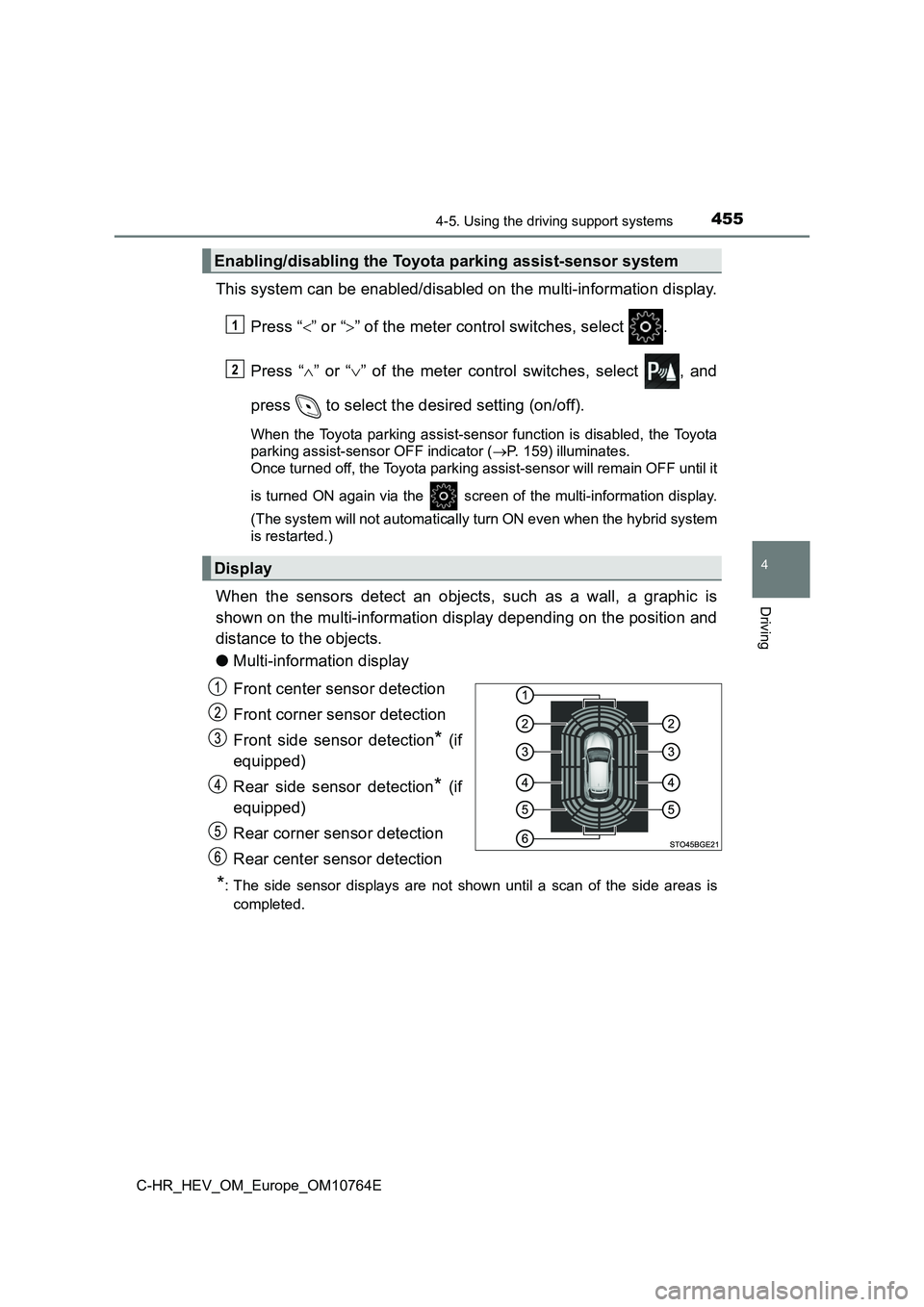
4554-5. Using the driving support systems
4
Driving
C-HR_HEV_OM_Europe_OM10764E
This system can be enabled/disabled on the multi-information display.
Press “ ” or “” of the meter control switches, select .
Press “ ” or “” of the meter control switches, select , and
press to select the desired setting (on/off).
When the Toyota parking assist-sensor function is disabled, the Toyota
parking assist-sensor OFF indicator ( P. 159) illuminates.
Once turned off, the Toyota parking assist-sensor will remain O FF until it
is turned ON again via the screen of the multi-information dis play.
(The system will not automatically turn ON even when the hybrid system
is restarted.)
When the sensors detect an objects, such as a wall, a graphic i s
shown on the multi-information display depending on the positio n and
distance to the objects.
● Multi-information display
Front center sensor detection
Front corner sensor detection
Front side sensor detection* (if
equipped)
Rear side sensor detection* (if
equipped)
Rear corner sensor detection
Rear center sensor detection
*: The side sensor displays are not shown until a scan of the sid e areas is
completed.
Enabling/disabling the Toyota parking assist-sensor system
Display
1
2
Page 460 of 814
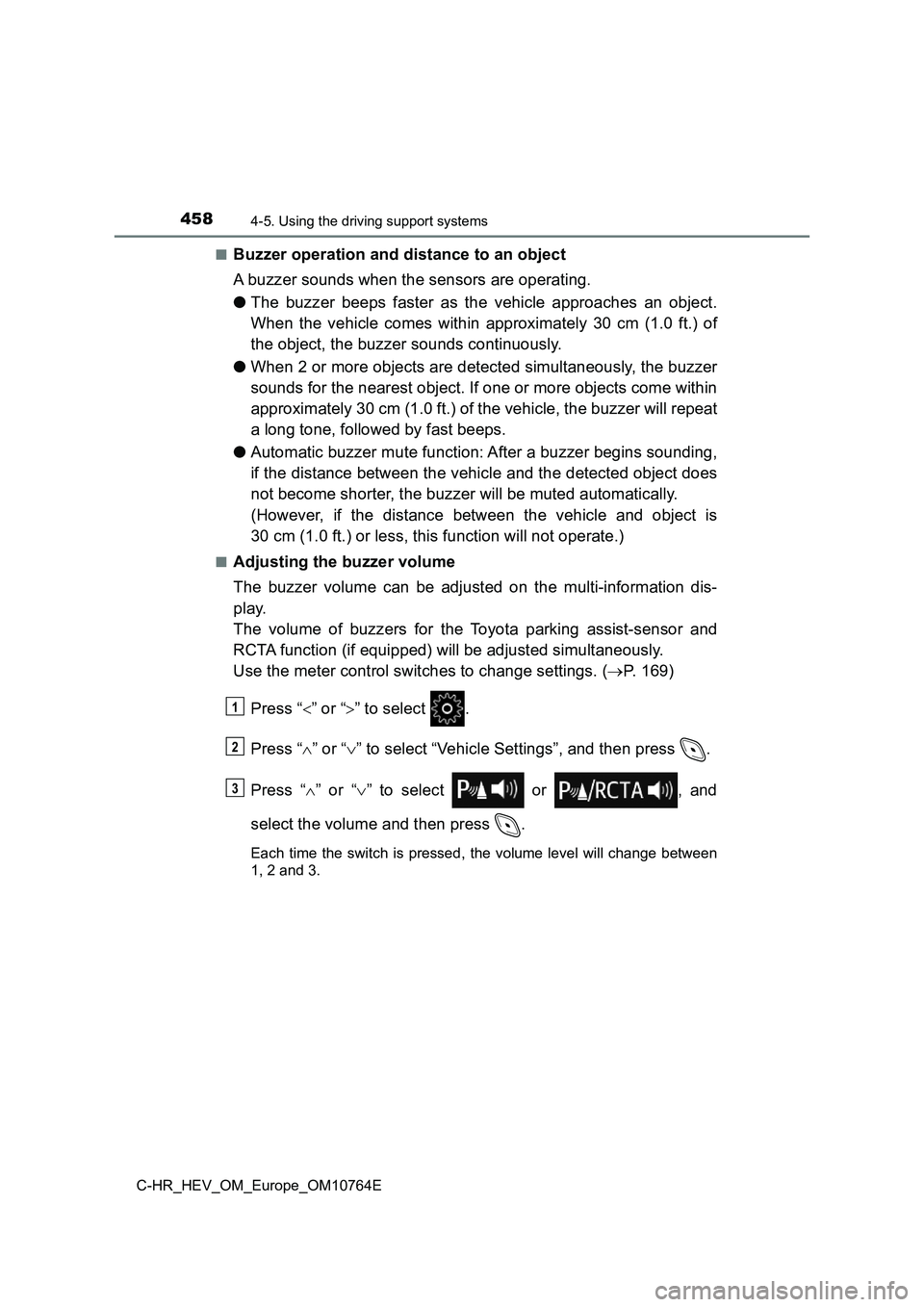
4584-5. Using the driving support systems
C-HR_HEV_OM_Europe_OM10764E
■Buzzer operation and distance to an object
A buzzer sounds when the sensors are operating.
● The buzzer beeps faster as the vehicle approaches an object.
When the vehicle comes within approximately 30 cm (1.0 ft.) of
the object, the buzzer sounds continuously.
● When 2 or more objects are detected simultaneously, the buzzer
sounds for the nearest object. If one or more objects come with in
approximately 30 cm (1.0 ft.) of the vehicle, the buzzer will r epeat
a long tone, followed by fast beeps.
● Automatic buzzer mute function: After a buzzer begins sounding,
if the distance between the vehicle and the detected object doe s
not become shorter, the buzzer will be muted automatically.
(However, if the distance between the vehicle and object is
30 cm (1.0 ft.) or less, this function will not operate.)
■Adjusting the buzzer volume
The buzzer volume can be adjusted on the multi-information dis-
play.
The volume of buzzers for the Toyota parking assist-sensor and
RCTA function (if equipped) will be adjusted simultaneously.
Use the meter control switches to change settings. ( P. 169)
Press “ ” or “” to select .
Press “ ” or “” to select “Vehicle Settings”, and then press .
Press “ ” or “” to select or , and
select the volume and then press .
Each time the switch is pressed, the volume level will change b etween
1, 2 and 3.
1
2
3
Page 461 of 814
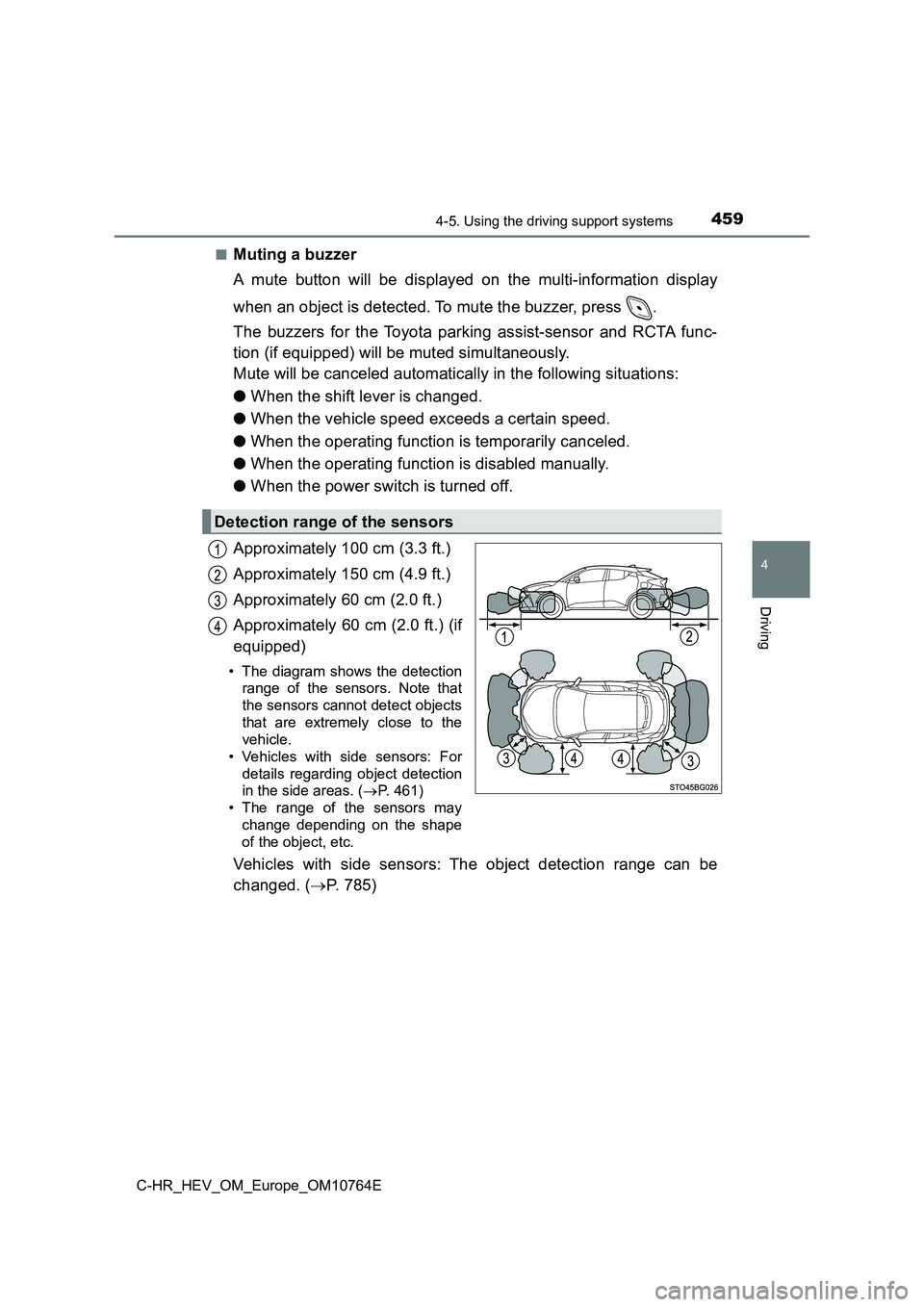
4594-5. Using the driving support systems
4
Driving
C-HR_HEV_OM_Europe_OM10764E
■Muting a buzzer
A mute button will be displayed on the multi-information displa y
when an object is detected. To mute the buzzer, press .
The buzzers for the Toyota parking assist-sensor and RCTA func-
tion (if equipped) will be muted simultaneously.
Mute will be canceled automatically in the following situations :
● When the shift lever is changed.
● When the vehicle speed exceeds a certain speed.
● When the operating function is temporarily canceled.
● When the operating function is disabled manually.
● When the power switch is turned off.
Approximately 100 cm (3.3 ft.)
Approximately 150 cm (4.9 ft.)
Approximately 60 cm (2.0 ft.)
Approximately 60 cm (2.0 ft.) (if
equipped)
• The diagram shows the detection
range of the sensors. Note that
the sensors cannot detect objects
that are extremely close to the
vehicle.
• Vehicles with side sensors: For
details regarding object detection
in the side areas. ( P. 461)
• The range of the sensors may
change depending on the shape
of the object, etc.
Vehicles with side sensors: The object detection range can be
changed. ( P. 7 8 5 )
Detection range of the sensors
Page 462 of 814
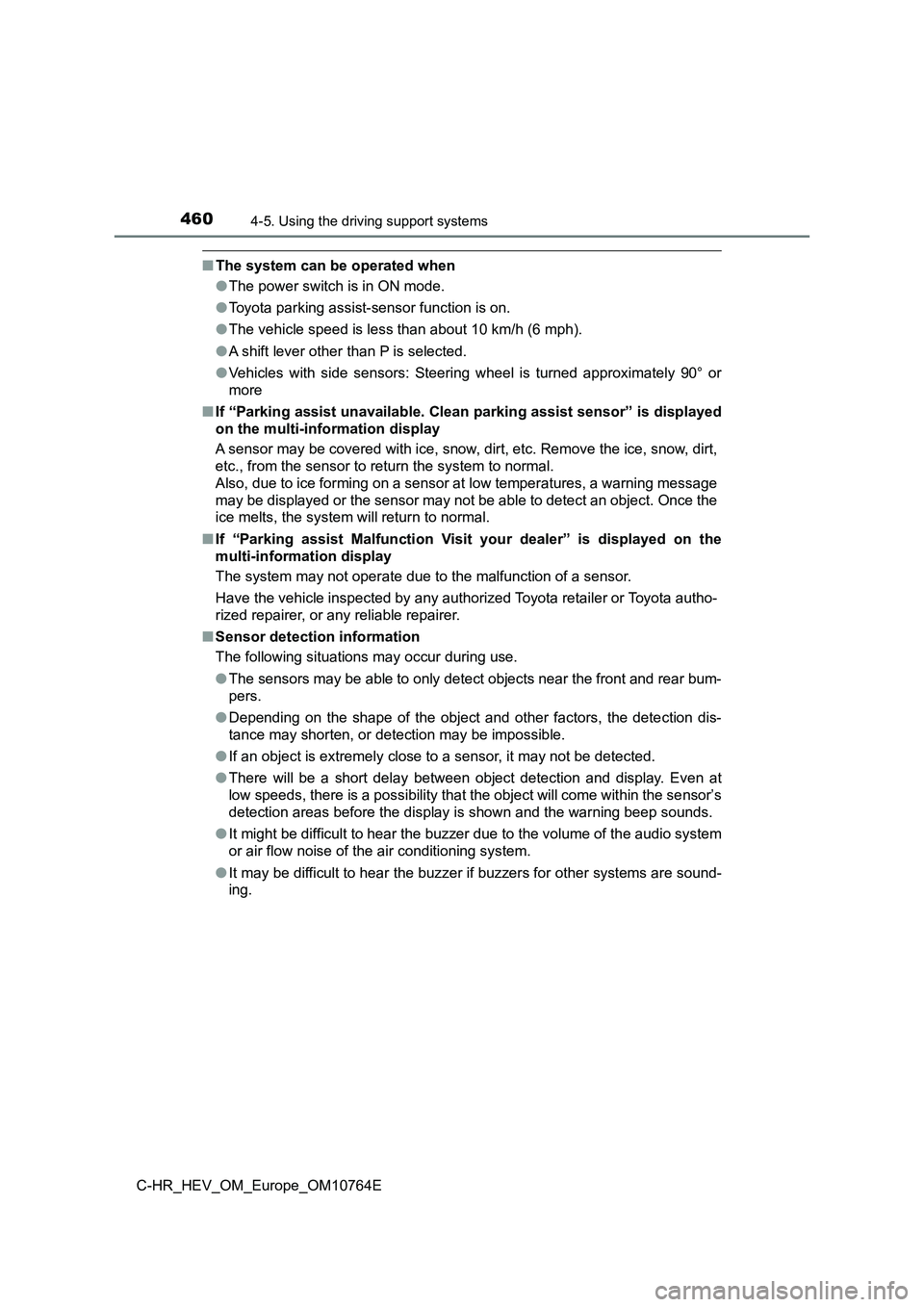
4604-5. Using the driving support systems
C-HR_HEV_OM_Europe_OM10764E
■The system can be operated when
● The power switch is in ON mode.
● Toyota parking assist-sensor function is on.
● The vehicle speed is less than about 10 km/h (6 mph).
● A shift lever other than P is selected.
● Vehicles with side sensors: Steering wheel is turned approximately 90° or
more
■ If “Parking assist unavailable. Clean parking assist sensor” is displayed
on the multi-information display
A sensor may be covered with ice, snow, dirt, etc. Remove the i ce, snow, dirt,
etc., from the sensor to return the system to normal.
Also, due to ice forming on a sensor at low temperatures, a war ning message
may be displayed or the sensor may not be able to detect an obj ect. Once the
ice melts, the system will return to normal.
■ If “Parking assist Malfunction Visit your dealer” is displayed on the
multi-information display
The system may not operate due to the malfunction of a sensor.
Have the vehicle inspected by any authorized Toyota retailer or Toyota autho-
rized repairer, or any reliable repairer.
■ Sensor detection information
The following situations may occur during use.
● The sensors may be able to only detect objects near the front and rear bum-
pers.
● Depending on the shape of the object and other factors, the detection dis-
tance may shorten, or detection may be impossible.
● If an object is extremely close to a sensor, it may not be detected.
● There will be a short delay between object detection and display. Even at
low speeds, there is a possibility that the object will come wi thin the sensor’s
detection areas before the display is shown and the warning bee p sounds.
● It might be difficult to hear the buzzer due to the volume of the audio system
or air flow noise of the air conditioning system.
● It may be difficult to hear the buzzer if buzzers for other systems are sound-
ing.
Page 473 of 814
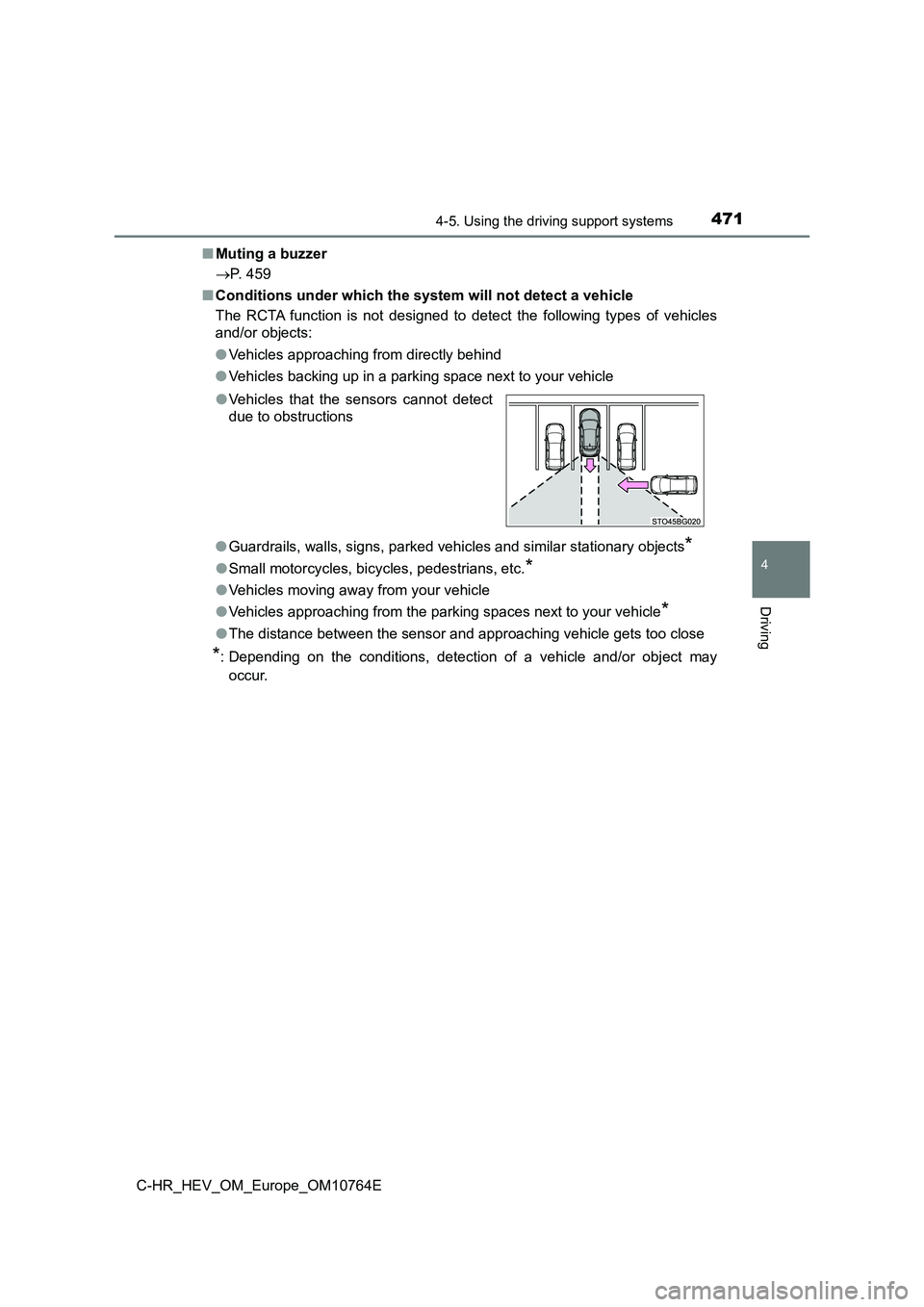
4714-5. Using the driving support systems
4
Driving
C-HR_HEV_OM_Europe_OM10764E
■ Muting a buzzer
P. 459
■ Conditions under which the system will not detect a vehicle
The RCTA function is not designed to detect the following types of vehicles
and/or objects:
● Vehicles approaching from directly behind
● Vehicles backing up in a parking space next to your vehicle
● Guardrails, walls, signs, parked vehicles and similar stationary objects*
●Small motorcycles, bicycles, pedestrians, etc.*
●Vehicles moving away from your vehicle
● Vehicles approaching from the parking spaces next to your vehicle*
●The distance between the sensor and approaching vehicle gets too close
*: Depending on the conditions, detection of a vehicle and/or object may
occur.
● Vehicles that the sensors cannot detect
due to obstructions
Page 477 of 814
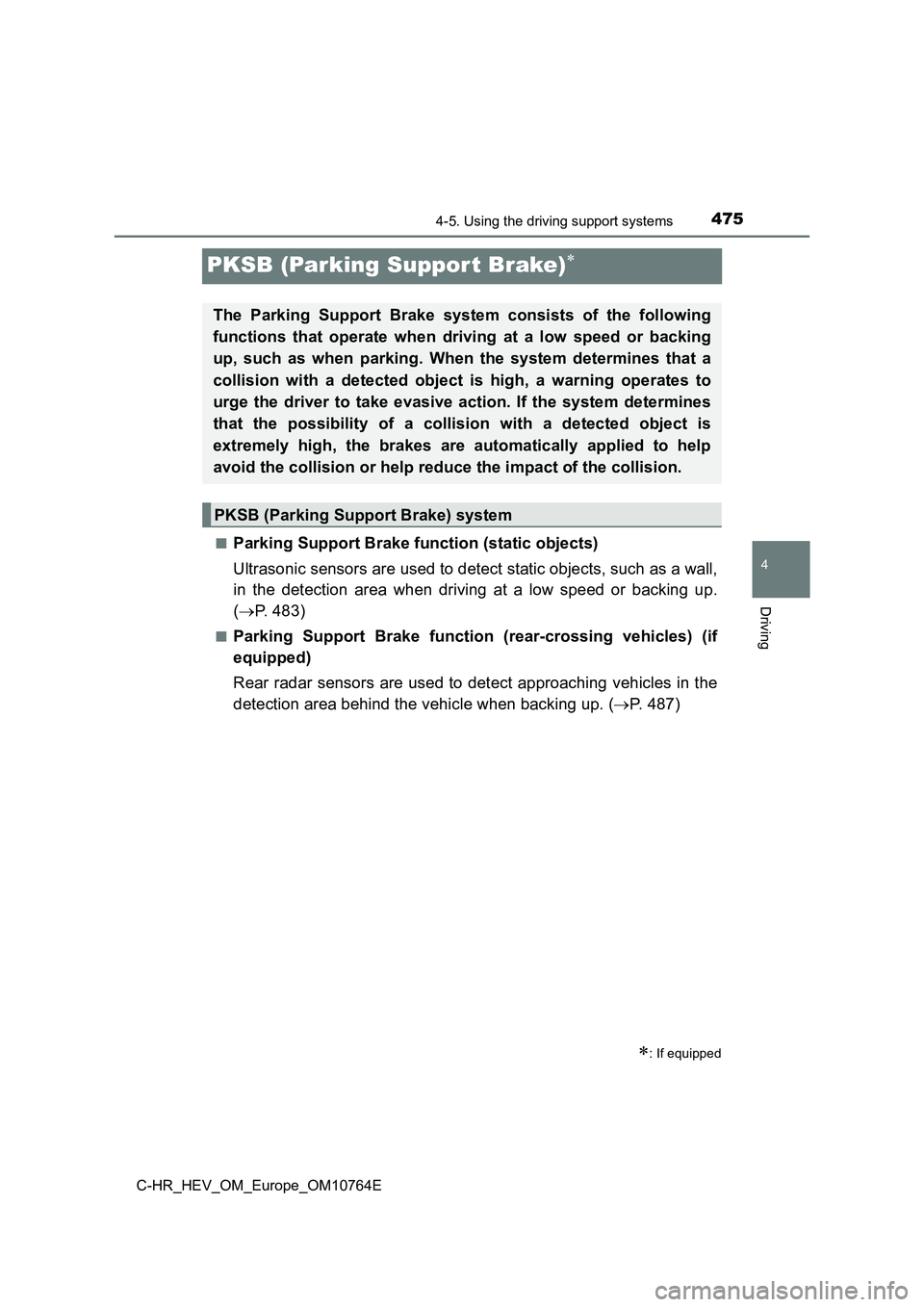
475
4
4-5. Using the driving support systems
Driving
C-HR_HEV_OM_Europe_OM10764E
PKSB (Parking Suppor t Brake)
■Parking Support Brake function (static objects)
Ultrasonic sensors are used to detect static objects, such as a wall,
in the detection area when driving at a low speed or backing up .
( P. 483)
■Parking Support Brake function (rear-crossing vehicles) (if
equipped)
Rear radar sensors are used to detect approaching vehicles in t he
detection area behind the vehicle when backing up. ( P. 4 8 7 )
: If equipped
The Parking Support Brake system consists of the following
functions that operate when driving at a low speed or backing
up, such as when parking. When the system determines that a
collision with a detected object is high, a warning operates to
urge the driver to take evasive action. If the system determine s
that the possibility of a collision with a detected object is
extremely high, the brakes are automatically applied to help
avoid the collision or help reduce the impact of the collision.
PKSB (Parking Support Brake) system
Page 484 of 814
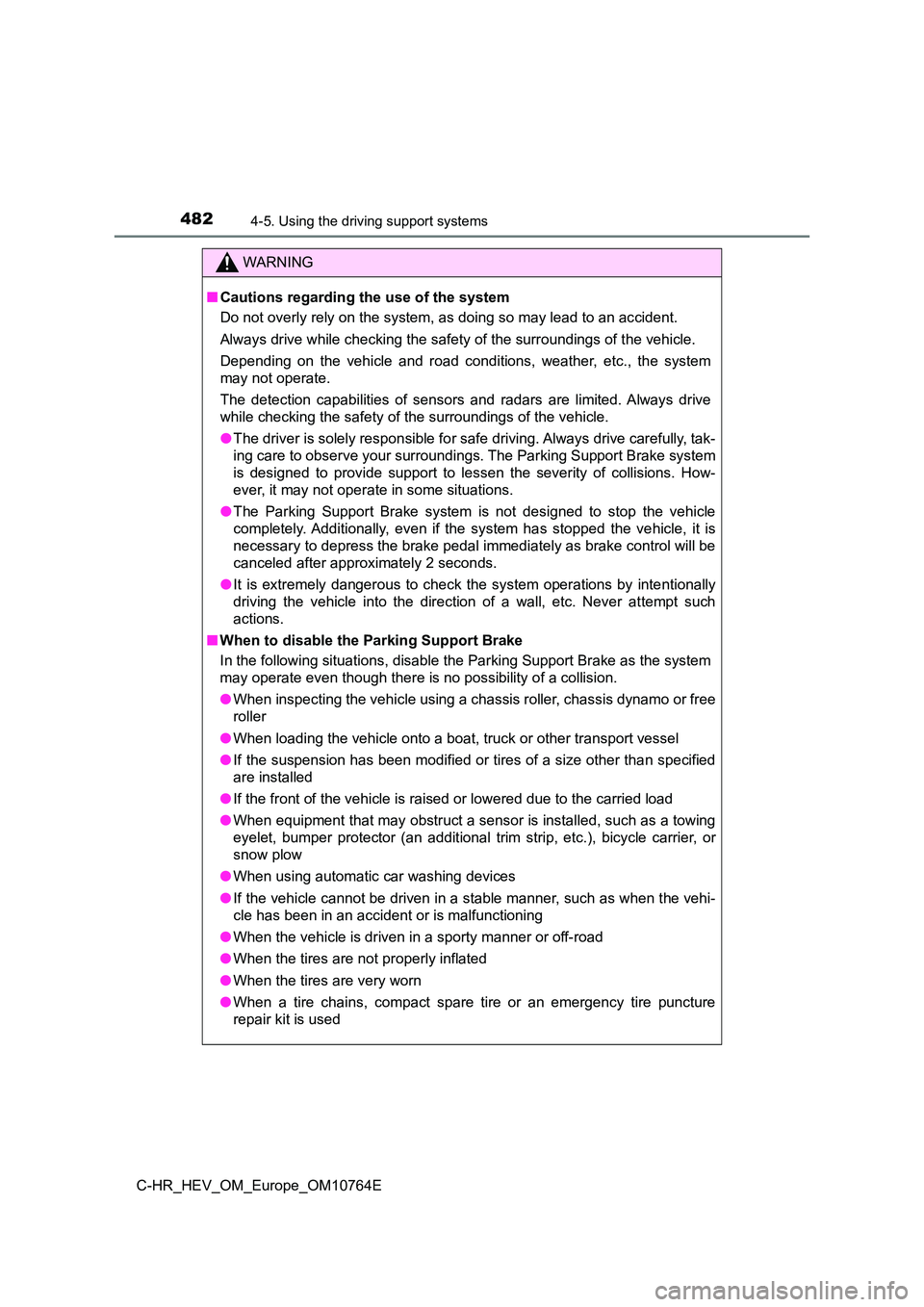
4824-5. Using the driving support systems
C-HR_HEV_OM_Europe_OM10764E
WARNING
■Cautions regarding the use of the system
Do not overly rely on the system, as doing so may lead to an ac cident.
Always drive while checking the safety of the surroundings of t he vehicle.
Depending on the vehicle and road conditions, weather, etc., th e system
may not operate.
The detection capabilities of sensors and radars are limited. A lways drive
while checking the safety of the surroundings of the vehicle.
● The driver is solely responsible for safe driving. Always drive carefully, tak-
ing care to observe your surroundings. The Parking Support Brak e system
is designed to provide support to lessen the severity of collis ions. How-
ever, it may not operate in some situations.
● The Parking Support Brake system is not designed to stop the vehicle
completely. Additionally, even if the system has stopped the ve hicle, it is
necessary to depress the brake pedal immediately as brake contr ol will be
canceled after approximately 2 seconds.
● It is extremely dangerous to check the system operations by intentionally
driving the vehicle into the direction of a wall, etc. Never at tempt such
actions.
■ When to disable the Parking Support Brake
In the following situations, disable the Parking Support Brake as the system
may operate even though there is no possibility of a collision.
● When inspecting the vehicle using a chassis roller, chassis dynamo or free
roller
● When loading the vehicle onto a boat, truck or other transport vessel
● If the suspension has been modified or tires of a size other than specified
are installed
● If the front of the vehicle is raised or lowered due to the carried load
● When equipment that may obstruct a sensor is installed, such as a towing
eyelet, bumper protector (an addi tional trim strip, etc.), bicycle carrier, or
snow plow
● When using automatic car washing devices
● If the vehicle cannot be driven in a stable manner, such as when the vehi-
cle has been in an accident or is malfunctioning
● When the vehicle is driven in a sporty manner or off-road
● When the tires are not properly inflated
● When the tires are very worn
● When a tire chains, compact spare tire or an emergency tire puncture
repair kit is used
Page 485 of 814
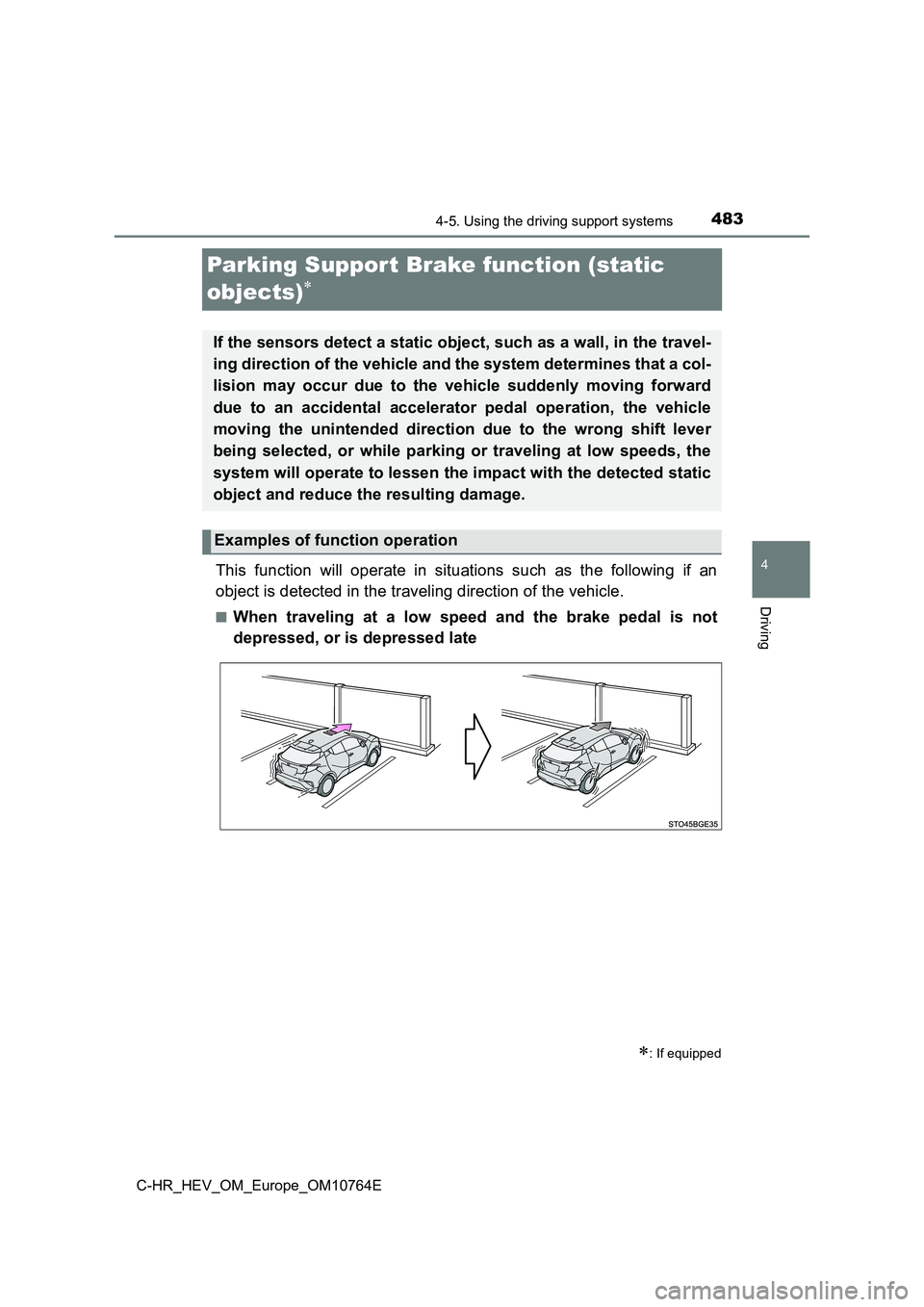
483
4
4-5. Using the driving support systems
Driving
C-HR_HEV_OM_Europe_OM10764E
Parking Support Brake function (static
objects)
This function will operate in situations such as the following if an
object is detected in the traveling direction of the vehicle.
■When traveling at a low speed and the brake pedal is not
depressed, or is depressed late
: If equipped
If the sensors detect a static object, such as a wall, in the t ravel-
ing direction of the vehicle and the system determines that a c ol-
lision may occur due to the vehicle suddenly moving forward
due to an accidental accelerator pedal operation, the vehicle
moving the unintended direction due to the wrong shift lever
being selected, or while parking or traveling at low speeds, th e
system will operate to lessen the impact with the detected stat ic
object and reduce the resulting damage.
Examples of function operation
Page 489 of 814
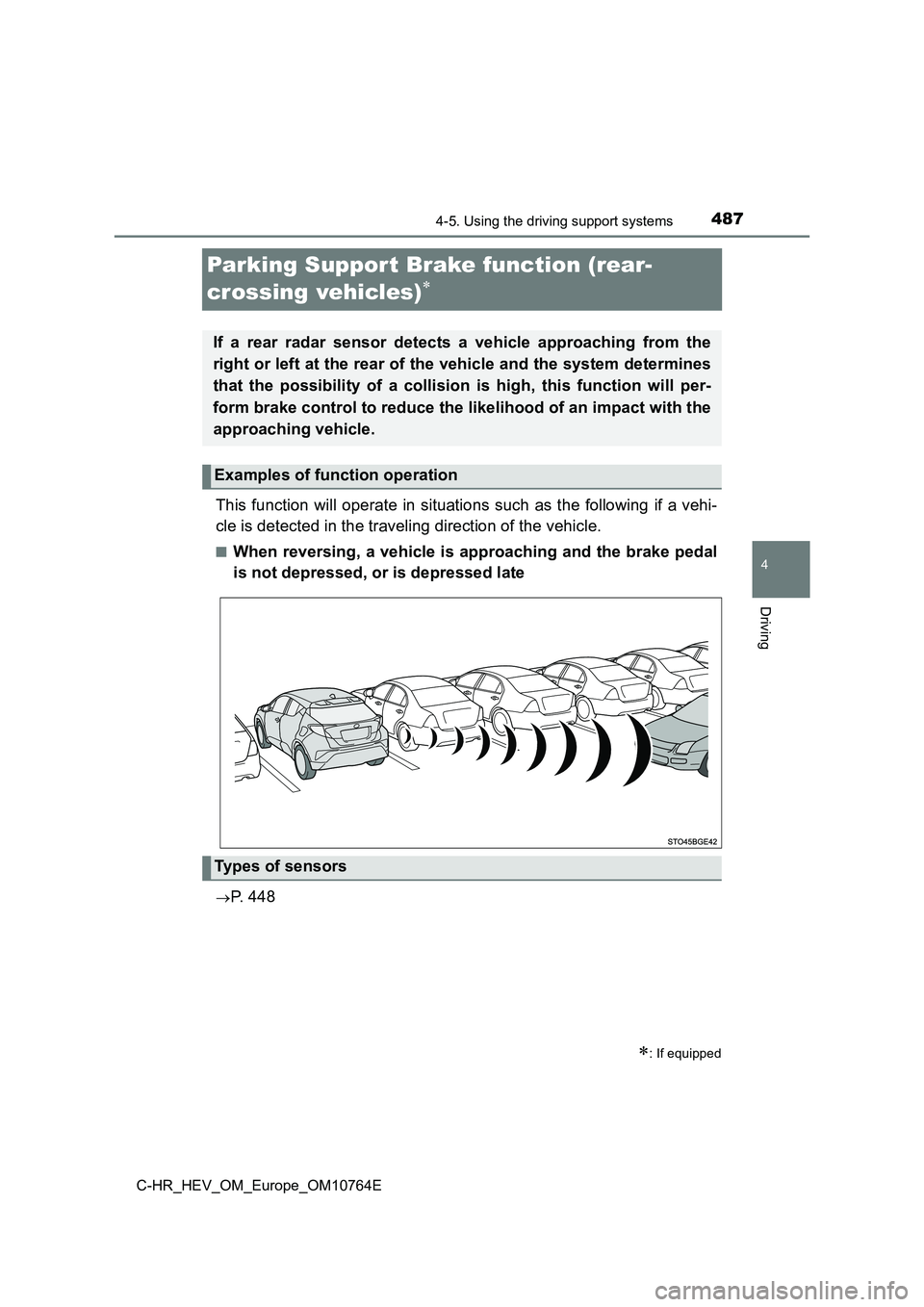
487
4
4-5. Using the driving support systems
Driving
C-HR_HEV_OM_Europe_OM10764E
Parking Support Brake function (rear-
crossing vehicles)
This function will operate in situations such as the following if a vehi-
cle is detected in the traveling direction of the vehicle.
■When reversing, a vehicle is approaching and the brake pedal
is not depressed, or is depressed late
P. 448
: If equipped
If a rear radar sensor detects a vehicle approaching from the
right or left at the rear of the vehicle and the system determi nes
that the possibility of a collision is high, this function will per-
form brake control to reduce the likelihood of an impact with t he
approaching vehicle.
Examples of function operation
Types of sensors